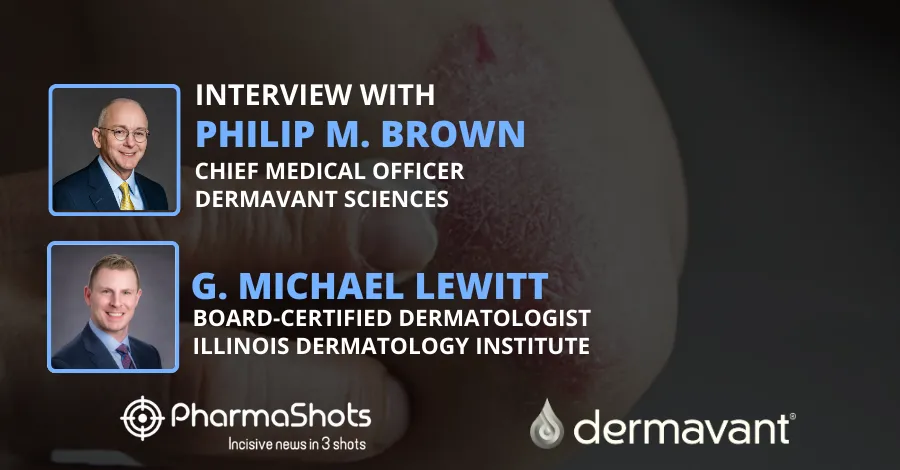
PharmaShots Interview: Dermavant’s Philip M. Brown Shares Insights on the Clinical Data of Tapinarof Published in NEJM
In an interview with PharmaShots, Philip M. Brown, MD, JD, Chief Medical Officer at Dermavant shares his views on the P-III (PSOARING 1 & 2) trials of tapinarof for the treatment of Plaque Psoriasis
Shots:
- The P-III (PSOARING 1 & 2) trials evaluate the efficacy and safety of tapinarof (1%, qd) vs vehicle-controlled cream in a ratio (2:1) in 1025 patients aged 18-75yrs. with PsO
- The studies met primary efficacy EPs & 2EPs i.e., @12wks., patients achieved a PGA response (35.4% vs 6.0%) & (40.2% vs 6.3%) with a minimum 2-grade improvement from baseline, 75% improvement in the PASI score (PASI75) (36.1% vs 10.2%) & (47.6% vs 6.9%), mean change in the percent of total body-surface area affected
- Additionally, the therapy showed an improvement of 90% in the PASI (PASI90) from baseline (18.8 vs 1.6%) & (20.9% vs 2.5%). The FDA accepts an application with an anticipated PDUFA date in Q2’22
Tuba: Can you please tell us about the title and data that is covered in the NEJM publication?
Philip Brown: The tapinarof primary manuscript, “Phase 3 Trials of Tapinarof Cream for Plaque Psoriasis,” was published in The New England Journal of Medicine (NEJM) on December 9, 2021. It covers the research findings of the PSOARING 1 and PSOARING 2 pivotal trials, which studied the efficacy and safety of the investigational drug tapinarof cream for the treatment of plaque psoriasis in adults.
Tuba: Briefly discuss tapinarof (MoA, Dosing, RoA).
Philip Brown: The investigational drug tapinarof is a novel, nonsteroidal, once-daily, topical cream — a cosmetically-elegant, potential first-in-class plaque psoriasis treatment for adults. Tapinarof binds to and activates the aryl hydrocarbon receptor (AhR), which downregulates proinflammatory cytokines implicated in plaque psoriasis (e.g., IL-17A and IL-17F), promotes skin barrier normalization, and increases antioxidant activity.
In August 2021, the FDA accepted a New Drug Application for tapinarof cream, 1% for the treatment of plaque psoriasis in adult patients, and assigned a Prescription Drug User Fee Act target action date in Q2 2022.
Tuba: What were the study design of the PSOARING 1 and PSOARING 2 trial?
Philip Brown: Dermavant’s pivotal Phase 3 clinical program for tapinarof cream, 1% in adult plaque psoriasis consists of PSOARING 1 (NCT03956355) and PSOARING 2 (NCT03983980), as well as PSOARING 3 (NCT04053387), a long-term extension (LTE) study.
PSOARING 1 and PSOARING 2, which collectively enrolled 1,025 patients, were two identically designed, multi-center, randomized, vehicle-controlled, double-blind, parallel-group studies conducted in North America that evaluated the safety and efficacy of tapinarof cream, 1% dosed once daily (QD) for 12 weeks versus vehicle QD in adult patients aged 18-75 years diagnosed with plaque psoriasis. The primary endpoint of both studies was the proportion of patients who achieved a Physician Global Assessment (PGA) score of clear (0) or almost clear (1) with a minimum 2-grade improvement from baseline at Week 12. Greater than 90% of eligible patients who completed PSOARING 1 and PSOARING 2 enrolled in PSOARING 3 LTE for an additional 40 weeks of open-label treatment.
Tuba: Can we discuss the results/outcome measures of PSOARING studies?
Philip Brown: In the pivotal studies PSOARING 1 and PSOARING 2, tapinarof cream, 1% demonstrated early onset of action, clinically meaningful and highly statistically significant improvements for all primary efficacy endpoints (PGA of 0 or 1 and ≥2-grade improvement at Week 12), secondary efficacy endpoints (including PASI75), and patient-reported outcomes compared with vehicle in adult patients with plaque psoriasis.
Most treatment-emergent adverse events were mild or moderate and did not lead to trial discontinuation in PSOARING 1 and PSOARING 2. Most common (≥1% in any group) treatment-related TEAEs were folliculitis, contact dermatitis, headache, pruritus, and dermatitis. Tapinarof cream, 1% QD was well-tolerated as reported by patients and investigators, including when applied to sensitive and intertriginous areas.
The combination of the efficacy, safety profile, and tolerability of tapinarof cream, 1% supports the potential for lack of restrictions on site, duration, and extent of use, which could provide an effective long-term topical treatment option for adult patients with plaque psoriasis.
Tuba: Why there are two studies (PSOARING 1 and PSOARING 2) rather than one, what is the difference between these two studies?
Philip Brown: PSOARING 1 and PSOARING 2 were identical in study design with consistent efficacy and safety results.
The two positive identically designed and conducted trials meet the standards set by the FDA draft guidance on demonstrating substantial evidence of effectiveness.
Tuba: What is plaque psoriasis? Also explain its causes, symptoms, and diagnosis.
Philip Brown: Psoriasis is a chronic, systemic, inflammatory skin disease associated with a significant physical and psychological burden. Psoriasis affects approximately 8 million people in the US and 125 million people worldwide. Plaque psoriasis, also called psoriasis Vulgaris, is the most common form and affects about 80–90% of people with psoriasis.
Psoriasis is a complex autoimmune disease, meaning that the body’s immune system targets and attacks its own cells which leads to over-production of skin cells and inflammation. Psoriasis has a genetic link, as it is more common in people who have family members with the disease. People with psoriasis are at an increased risk of developing other chronic and serious health conditions, including psoriatic arthritis, inflammatory bowel disease, hypertension, diabetes, obesity, and depression.
Psoriasis is a chronic disease that can wax and wane, with periods of worsening and periods of milder symptoms or remission. It is not contagious and cannot be transmitted by touching someone who has it. Plaque psoriasis is characterized by raised, red patches of skin, often with silvery scales. Psoriatic plaques most commonly occur on the scalp, trunk, buttocks, and limbs, affecting both sides of the body in a symmetrical distribution.
Diagnosis of plaque psoriasis is primarily through an evaluation of medical history and physical exam of the skin, scalp, and nails. Validated measures such as the Physician Global Assessment (PGA) and Psoriasis Area and Severity Index (PASI) are used to assess disease severity. About 80% of patients with plaque psoriasis have mild to moderate disease, with the remaining 20% having moderate to severe disease.
Tuba: Are you planning to conduct any additional studies for tapinarof?
Philip Brown: Dermavant Sciences is currently recruiting for the following ongoing tapinarof clinical trials in plaque psoriasis and atopic dermatitis:
- ADORING Program: Tapinarof for the Treatment of Atopic Dermatitis in Children and Adults (NCT05014568; NCT05032859) and Long Term Extension Study of Tapinarof Cream, 1% for Subjects With Atopic Dermatitis (NCT05142774)
- Maximal Use Study of Tapinarof Cream, 1% in Pediatric Subjects With Extensive Atopic Dermatitis (NCT05186805)
- A Phase 3 Study of Tapinarof for the Treatment of Plaque Psoriasis in Pediatric Subjects (NCT05172726)
Tuba: What more are you exploring in the dermatology space?
Philip Brown: As a company, Dermavant Science is dedicated to making healthier skin a reality for millions of patients around the world living with chronic skin conditions. We are hard at work developing novel treatments to deliver groundbreaking science exactly where patients need it—their skin. Beyond plaque psoriasis and atopic dermatitis, our robust medical dermatology pipeline includes clinical-stage product candidates that target specific unmet needs in vitiligo, primary focal hyperhidrosis, and acne.
Source: Everyday Health
About Author:

Dr. Philip M. Brown is the MD, JD, Chief Medical Officer at Dermavant. He has over 25 years of experience leading clinical development programs. Dr. Brown received his MD from Texas Tech University Health Science Center School of Medicine, his JD from the University of Texas School of Law, and his BA from Hendrix College

This content piece was prepared by our former Senior Editor. She had expertise in life science research and was an avid reader. For any query reach out to us at connect@pharmashots.com













